Solar eclipse of July 29, 1878
| Solar eclipse of July 29, 1878 | |
|---|---|
| Type of eclipse | |
| Nature | Total |
| Gamma | 0.6232 |
| Magnitude | 1.045 |
| Maximum eclipse | |
| Duration | 191 s (3 min 11 s) |
| Coordinates | 53°48′N 124°00′W / 53.8°N 124°W |
| Max. width of band | 191 km (119 mi) |
| Times (UTC) | |
| Greatest eclipse | 21:47:18 |
| References | |
| Saros | 124 (47 of 73) |
| Catalog # (SE5000) | 9230 |
A total solar eclipse occurred at the Moon's descending node of orbit between Monday, July 29 and Tuesday, July 30, 1878, with a magnitude of 1.0450. A solar eclipse occurs when the Moon passes between Earth and the Sun, thereby totally or partly obscuring the image of the Sun for a viewer on Earth. A total solar eclipse occurs when the Moon's apparent diameter is larger than the Sun's, blocking all direct sunlight, turning day into darkness. Totality occurs in a narrow path across Earth's surface, with the partial solar eclipse visible over a surrounding region thousands of kilometres wide. Occurring about 2.4 days before perigee (on August 1, 1878, at 6:45 UTC), the Moon's apparent diameter was larger.[1]
The path of totality was visible from parts of modern-day eastern Russia, Alaska, western Canada, Washington, Idaho, Montana, Wyoming, Colorado, New Mexico, Kansas, Oklahoma, Texas, Louisiana, Cuba, Haiti, and the Dominican Republic. A partial solar eclipse was also visible for parts of Northeast Asia, North America, Central America, the Caribbean, and northern South America.
Newspapers in the United States reported of large migrations from the Midwest towards the path of totality to view the eclipse. Scientists observing from Pikes Peak in Colorado contended with altitude sickness and snowstorms, among other problems.[2][3]
High-altitude astronomy
[edit]The 1878 eclipse was a turning point in modern astronomy, because it was the first time that many of the world's leading astronomers had the opportunity to make their observations from the higher altitudes provided by the Rocky Mountains. After the 1878 eclipse, astronomers began to build observatories at locations well above sea level, including on the sides and summits of mountains, a scientific trend which extended throughout the twentieth century and into the twenty-first.[4]
Eclipse images
[edit]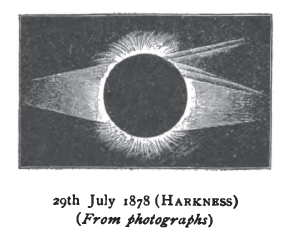
|
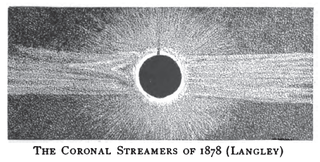
|

|

|

|
Eclipse details
[edit]Shown below are two tables displaying details about this particular solar eclipse. The first table outlines times at which the moon's penumbra or umbra attains the specific parameter, and the second table describes various other parameters pertaining to this eclipse.[5]
| Event | Time (UTC) |
|---|---|
| First Penumbral External Contact | 1878 July 29 at 19:18:31.9 UTC |
| First Umbral External Contact | 1878 July 29 at 20:23:40.9 UTC |
| First Central Line | 1878 July 29 at 20:24:46.4 UTC |
| First Umbral Internal Contact | 1878 July 29 at 20:25:52.4 UTC |
| Equatorial Conjunction | 1878 July 29 at 21:23:06.4 UTC |
| Ecliptic Conjunction | 1878 July 29 at 21:40:46.5 UTC |
| Greatest Duration | 1878 July 29 at 21:46:11.9 UTC |
| Greatest Eclipse | 1878 July 29 at 21:47:17.7 UTC |
| Last Umbral Internal Contact | 1878 July 29 at 23:08:56.0 UTC |
| Last Central Line | 1878 July 29 at 23:10:04.0 UTC |
| Last Umbral External Contact | 1878 July 29 at 23:11:11.6 UTC |
| Last Penumbral External Contact | 1878 July 30 at 00:16:08.9 UTC |
| Parameter | Value |
|---|---|
| Eclipse Magnitude | 1.04495 |
| Eclipse Obscuration | 1.09192 |
| Gamma | 0.62323 |
| Sun Right Ascension | 08h35m50.0s |
| Sun Declination | +18°38'42.9" |
| Sun Semi-Diameter | 15'45.4" |
| Sun Equatorial Horizontal Parallax | 08.7" |
| Moon Right Ascension | 08h36m44.1s |
| Moon Declination | +19°13'31.6" |
| Moon Semi-Diameter | 16'15.3" |
| Moon Equatorial Horizontal Parallax | 0°59'39.2" |
| ΔT | -4.7 s |
Eclipse season
[edit]This eclipse is part of an eclipse season, a period, roughly every six months, when eclipses occur. Only two (or occasionally three) eclipse seasons occur each year, and each season lasts about 35 days and repeats just short of six months (173 days) later; thus two full eclipse seasons always occur each year. Either two or three eclipses happen each eclipse season. In the sequence below, each eclipse is separated by a fortnight.
| July 29 Descending node (new moon) |
August 13 Ascending node (full moon) |
|---|---|
 |
|
| Total solar eclipse Solar Saros 124 |
Partial lunar eclipse Lunar Saros 136 |
Related eclipses
[edit]Eclipses in 1878
[edit]- An annular solar eclipse on February 2.
- A partial lunar eclipse on February 17.
- A total solar eclipse on July 29.
- A partial lunar eclipse on August 13.
Metonic
[edit]- Preceded by: Solar eclipse of October 10, 1874
- Followed by: Solar eclipse of May 17, 1882
Tzolkinex
[edit]- Preceded by: Solar eclipse of June 18, 1871
- Followed by: Solar eclipse of September 8, 1885
Half-Saros
[edit]- Preceded by: Lunar eclipse of July 23, 1869
- Followed by: Lunar eclipse of August 3, 1887
Tritos
[edit]- Preceded by: Solar eclipse of August 29, 1867
- Followed by: Solar eclipse of June 28, 1889
Solar Saros 124
[edit]- Preceded by: Solar eclipse of July 18, 1860
- Followed by: Solar eclipse of August 9, 1896
Inex
[edit]- Preceded by: Solar eclipse of August 18, 1849
- Followed by: Solar eclipse of July 10, 1907
Triad
[edit]- Preceded by: Solar eclipse of September 27, 1791
- Followed by: Solar eclipse of May 30, 1965
Solar eclipses of 1877–1880
[edit]This eclipse is a member of a semester series. An eclipse in a semester series of solar eclipses repeats approximately every 177 days and 4 hours (a semester) at alternating nodes of the Moon's orbit.[6]
The partial solar eclipses on March 15, 1877 and September 7, 1877 occur in the previous lunar year eclipse set, and the partial solar eclipse on December 2, 1880 occurs in the next lunar year eclipse set.
| Solar eclipse series sets from 1877 to 1880 | ||||||
|---|---|---|---|---|---|---|
| Descending node | Ascending node | |||||
| Saros | Map | Gamma | Saros | Map | Gamma | |
| 114 | August 9, 1877 Partial |
1.3277 | 119 | February 2, 1878 Annular |
−0.9071 | |
| 124 | July 29, 1878 Total |
0.6232 | 129 | January 22, 1879 Annular |
−0.1824 | |
| 134 | July 19, 1879 Annular |
−0.1439 | 139 | January 11, 1880 Total |
0.6136 | |
| 144 | July 7, 1880 Annular |
−0.9406 | 146 | December 31, 1880 Partial |
1.1591 | |
Saros 124
[edit]This eclipse is a part of Saros series 124, repeating every 18 years, 11 days, and containing 73 events. The series started with a partial solar eclipse on March 6, 1049. It contains total eclipses from June 12, 1211 through September 22, 1968, and a hybrid eclipse on October 3, 1986. There are no annular eclipses in this set. The series ends at member 73 as a partial eclipse on May 11, 2347. Its eclipses are tabulated in three columns; every third eclipse in the same column is one exeligmos apart, so they all cast shadows over approximately the same parts of the Earth.
The longest duration of totality was produced by member 39 at 5 minutes, 46 seconds on May 3, 1734. All eclipses in this series occur at the Moon’s descending node of orbit.[7]
| Series members 43–64 occur between 1801 and 2200: | ||
|---|---|---|
| 43 | 44 | 45 |
 June 16, 1806 |
 June 26, 1824 |
 July 8, 1842 |
| 46 | 47 | 48 |
 July 18, 1860 |
 July 29, 1878 |
 August 9, 1896 |
| 49 | 50 | 51 |
 August 21, 1914 |
 August 31, 1932 |
 September 12, 1950 |
| 52 | 53 | 54 |
 September 22, 1968 |
 October 3, 1986 |
 October 14, 2004 |
| 55 | 56 | 57 |
 October 25, 2022 |
 November 4, 2040 |
 November 16, 2058 |
| 58 | 59 | 60 |
 November 26, 2076 |
 December 7, 2094 |
 December 19, 2112 |
| 61 | 62 | 63 |
 December 30, 2130 |
 January 9, 2149 |
 January 21, 2167 |
| 64 | ||
 January 31, 2185 | ||
Metonic series
[edit]The metonic series repeats eclipses every 19 years (6939.69 days), lasting about 5 cycles. Eclipses occur in nearly the same calendar date. In addition, the octon subseries repeats 1/5 of that or every 3.8 years (1387.94 days). All eclipses in this table occur at the Moon's descending node.
| 22 eclipse events between March 5, 1848 and July 30, 1935 | ||||
|---|---|---|---|---|
| March 5–6 | December 22–24 | October 9–11 | July 29–30 | May 17–18 |
| 108 | 110 | 112 | 114 | 116 |
 March 5, 1848 |
 July 29, 1859 |
 May 17, 1863 | ||
| 118 | 120 | 122 | 124 | 126 |
 March 6, 1867 |
 December 22, 1870 |
 October 10, 1874 |
 July 29, 1878 |
 May 17, 1882 |
| 128 | 130 | 132 | 134 | 136 |
 March 5, 1886 |
 December 22, 1889 |
 October 9, 1893 |
 July 29, 1897 |
 May 18, 1901 |
| 138 | 140 | 142 | 144 | 146 |
 March 6, 1905 |
 December 23, 1908 |
 October 10, 1912 |
 July 30, 1916 |
 May 18, 1920 |
| 148 | 150 | 152 | 154 | |
 March 5, 1924 |
 December 24, 1927 |
 October 11, 1931 |
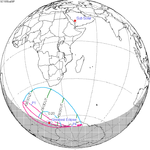 July 30, 1935 | |
Tritos series
[edit]This eclipse is a part of a tritos cycle, repeating at alternating nodes every 135 synodic months (≈ 3986.63 days, or 11 years minus 1 month). Their appearance and longitude are irregular due to a lack of synchronization with the anomalistic month (period of perigee), but groupings of 3 tritos cycles (≈ 33 years minus 3 months) come close (≈ 434.044 anomalistic months), so eclipses are similar in these groupings.
| Series members between 1801 and 2200 | ||||
|---|---|---|---|---|
 March 4, 1802 (Saros 117) |
 February 1, 1813 (Saros 118) |
 January 1, 1824 (Saros 119) |
 November 30, 1834 (Saros 120) |
 October 30, 1845 (Saros 121) |
 September 29, 1856 (Saros 122) |
 August 29, 1867 (Saros 123) |
 July 29, 1878 (Saros 124) |
 June 28, 1889 (Saros 125) |
 May 28, 1900 (Saros 126) |
 April 28, 1911 (Saros 127) |
 March 28, 1922 (Saros 128) |
 February 24, 1933 (Saros 129) |
 January 25, 1944 (Saros 130) |
 December 25, 1954 (Saros 131) |
 November 23, 1965 (Saros 132) |
 October 23, 1976 (Saros 133) |
 September 23, 1987 (Saros 134) |
 August 22, 1998 (Saros 135) |
 July 22, 2009 (Saros 136) |
 June 21, 2020 (Saros 137) |
 May 21, 2031 (Saros 138) |
 April 20, 2042 (Saros 139) |
 March 20, 2053 (Saros 140) |
 February 17, 2064 (Saros 141) |
 January 16, 2075 (Saros 142) |
 December 16, 2085 (Saros 143) |
 November 15, 2096 (Saros 144) |
 October 16, 2107 (Saros 145) |
 September 15, 2118 (Saros 146) |
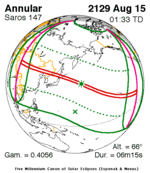 August 15, 2129 (Saros 147) |
 July 14, 2140 (Saros 148) |
 June 14, 2151 (Saros 149) |
 May 14, 2162 (Saros 150) |
 April 12, 2173 (Saros 151) |
 March 12, 2184 (Saros 152) |
 February 10, 2195 (Saros 153) | |||
Inex series
[edit]This eclipse is a part of the long period inex cycle, repeating at alternating nodes, every 358 synodic months (≈ 10,571.95 days, or 29 years minus 20 days). Their appearance and longitude are irregular due to a lack of synchronization with the anomalistic month (period of perigee). However, groupings of 3 inex cycles (≈ 87 years minus 2 months) comes close (≈ 1,151.02 anomalistic months), so eclipses are similar in these groupings.
| Series members between 1801 and 2200 | ||
|---|---|---|
 September 7, 1820 (Saros 122) |
 August 18, 1849 (Saros 123) |
 July 29, 1878 (Saros 124) |
 July 10, 1907 (Saros 125) |
 June 19, 1936 (Saros 126) |
 May 30, 1965 (Saros 127) |
 May 10, 1994 (Saros 128) |
 April 20, 2023 (Saros 129) |
 March 30, 2052 (Saros 130) |
 March 10, 2081 (Saros 131) |
 February 18, 2110 (Saros 132) |
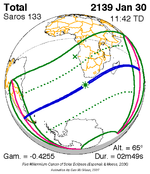 January 30, 2139 (Saros 133) |
 January 10, 2168 (Saros 134) |
 December 19, 2196 (Saros 135) |
|
References
[edit]- ^ "Moon Distances for London, United Kingdom, England". timeanddate. Retrieved 29 August 2024.
- ^ Ruskin, Steve (2008). "'Among the Favored Mortals of Earth': The Press, State Pride, and the Great Eclipse of 1878". Colorado Heritage.
- ^ Waxman, Olivia B. (August 18, 2017). "Think This Total Solar Eclipse Is Getting a Lot of Hype? You Should Have Seen 1878". TIME. Retrieved August 22, 2017.
- ^ Ruskin, Steven (22 July 2017). America's first great eclipse : how scientists, tourists, and the Rocky Mountain eclipse of 1878 changed astronomy forever. [United States]. ISBN 9780999140901. OCLC 992174591.
{{cite book}}: CS1 maint: location missing publisher (link) - ^ "Total Solar Eclipse of 1878 Jul 29". EclipseWise.com. Retrieved 29 August 2024.
- ^ van Gent, R.H. "Solar- and Lunar-Eclipse Predictions from Antiquity to the Present". A Catalogue of Eclipse Cycles. Utrecht University. Retrieved 6 October 2018.
- ^ "NASA - Catalog of Solar Eclipses of Saros 124". eclipse.gsfc.nasa.gov.
- NASA graphic
- Sketch of Solar Corona July 29, 1878
- Mabel Loomis Todd (1900). Total Eclipses of the Sun. Little, Brown.
Further reading
[edit]- David Baron (2017). American Eclipse: A Nation's Epic Race to Catch the Shadow of the Moon and Win the Glory of the World. Liveright. ISBN 978-1631490163.
- Steve Ruskin (2017). America's First Great Eclipse: How Scientists, Tourists, and the Rocky Mountain Eclipse of 1878 Changed Astronomy Forever. Alpine Alchemy Press. ISBN 978-0999140901.
- Steve Ruskin (2008). "'Among the Favored Mortals of Earth': The Press, State Pride, and the Great Eclipse of 1878." Colorado Heritage 28(3), 22–35.
External links
[edit]- See You on the Dark Side of the Moon (Notre Dame Magazine)
- The Eclipse That Made America Great (The Atlantic)




